Advertisement
If you have a new account but are having problems posting or verifying your account, please email us on hello@boards.ie for help. Thanks :)
Hello all! Please ensure that you are posting a new thread or question in the appropriate forum. The Feedback forum is overwhelmed with questions that are having to be moved elsewhere. If you need help to verify your account contact hello@boards.ie
Adopting a rescue pup
-
02-01-2011 12:27am#1Since this has been discussed a few times on this forum, I thought I'd share my experience and we'll see how people feel.
This is Gus (in front with the white head):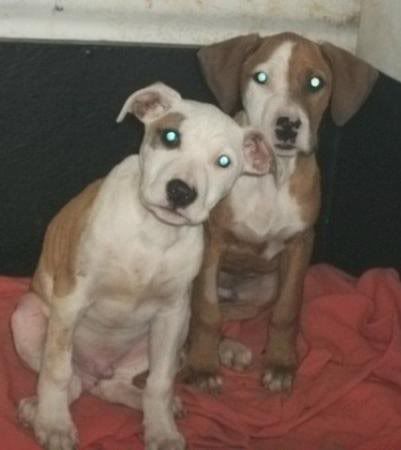
When I met him at the shelter, he was underweight, filthy, and 12 weeks old. He was described as a "staffy cross". He's not a staffy cross, from what I can tell: he's a bull arab. The difference, if you assume a staffy cross would hit 20-25kgs fully grown, will be about 15-20kgs in Gus's full grown size.
First caveat of shelter dogs: you don't know what you're getting if you get a mongrel mix, so learn to judge the size of the pup relative to its age, and watch the paws and ears relative to the dog's frame for an idea of how large it will grow.
At the shelter, I was able to spend some time with Gus and with other puppies. I got down to his level to see how he reacted to me. I sent my husband into the pen, wearing his flourescent yellow bulky ski jacket, to see how Gus would react to a bloke. As Gus was eating I put my hand in his food bowl (given that he's a 12 week old pup!) and offered him a handful of his kibble - he barely reacted except to snaffle the food happily out of my hand. (A mastiff cross puppy in another pen, at 8 weeks old, froze and gave me a whale-eye look when I put my hand near her food bowl. Not a good start in a dog that'll grow to 50kgs.) I put Gus on a lead and brought him around the shelter for a bit to see how he interacted with other dogs and the cats and animals at the shelter.
First major advantage of shelter dogs: you have an opportunity to assess the dog's temperament and reactions before you take it home - you don't get this option with a pedigree purchase, and your new pup is often bought and paid for before you even meet it, let alone get a chance to interact with it.
When I got Gus home and washed him, he had chronic ringworm and was crawling with fleas - here's him the first night, after his flea-bath.
Second caveat of rescue dogs: they can come with illnesses, however illnesses are treatable, and these days a pedigree is not a guarantee of health, especially if you've been fooled by a breeder's credentials. Be aware of the potential for health issues with any dog you buy - rescue or pedigree, and especially with designer crossbreeds!
The first two months with Gus were all about getting him over his infestations and toilet training him. After a month he had the ringworm all-clear. However up to that point, I had to quarantine him at my house, in my bathroom - during the vital socialisation period of 12-16 weeks. However this quarantine didn't have a bad affect on him, because he'd spend time in a shelter and was surrounded by other animals, strange people, plenty of dogs, so on.
Again major shelter dog advantage around temperament - Gus was able to take the confines of quarantine because that's the kind of dog he is - nurture is very important, but nature is very individual and breed is not a rock solid guarantee of temperament!
Once Gus's weight and health came up to a good standard, his growth took off. Staffy cross my arse - at six months he was the size of a staffy and gaining 1kg in weight a week, suggesting that his six month size is half his adult size.
Given that I adopted him at 12 weeks of age, in spite of his issues, I was still able to socialise him with my cats. He started to attend obedience classes with me from the age of 6 months - older than you might consider starting with many dogs, but the advantage is I chose an obedience class, not a specific puppy class. Obedience class has been invaluable.
Third and most important caveat of rescue dogs: they have a past.
Even at 12 weeks, Gus had already been starved, kicked, and kept in the boot of a car in his own urine and faeces. This meant I ended up with a growing pup who was difficult to toilet train because he didn't have the fastidiousness of puppies who've been kept clean. This meant crate training was off the board for me - it was inappropriate to confine a dog who had already suffered confinement.
However, we managed it with toilet training. It's doable - be persistent, even with a 'problem' dog. The biggest problem we had, however, was the car.
Given his past in the boot of a car, Gus HATED the car. The first few weeks I drove him anywhere he shat or puked in the car EVERY. SINGLE. TIME.
I became an expert at removed a crap or puke-covered short-haired puppy from my car and washing him down in 30 seconds flat. I travelled with towels, bottles of water, cloths and plastic bags so I could clean both him and the car when we arrived at our destination. Crating him again was inappropriate because confinement distresses him further instead of calming him down.
However, obedience class helped again - we worked out methods of getting Gus to associate the car with positive things, breaking his fear of it, until eventually now he'll hop into the back seat voluntarily. He doesn't love it, but I'm glad that I no longer have to lift a large-breed growing puppy into and out of my 4x4.
Rescue or pedigree, obedience class helps create a happy dog!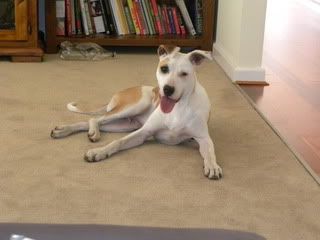
Gus was eight months old on 1st January. He is an attentive, sweet-natured hound. He's an odd-looking lad who's turning into a great big brute, but we still love him. It's been a steep learning curve, but worth it every second of the way. Things I wish I'd known include not bothering to buy him a bed, just use cardboard box and towels because he ate every feckin bed we gave him until he was six months old. Cordoning off part of the yard as a dog run was the best thing we ever did - as a large-breed hound, Gus is a digger and a ransacker ("Honey! The dog's remodelling the yard again!") and the run means he can dig and ransack in there and not wreck my entire yard.
However - and the point of this thread - at eight months I can tell you my rescue dog, in spite of his poor start, is no different to a pedigree pup at eight months. He chews stuff. He digs. He has selectively deaf days. He's playful. He's affectionate. He'll gallavant for 12 hours one day and sleep for 12 hours the next. In fact, being a lover of large breeds, I may have gone for a GSD, mastiff or rottweiler instead of Gus if I'd gone pedigree, and I may not be having as easy a time as I'm having right now, even with a pedigree dog with an allegedly set temperament.
Gus rarely barks or whinges. He doesn't jump the fence. He isn't remotely food or resource aggressive - or even possessive. He sits, lies down, stays, fetches and understands no, yes, in, out and wait. He lives - God love him - with six cats and, while he's not in bed with them, his vastly superior size and weight apparently haven't occurred to him and my 4.5kg burmese cross smacks him up regularly.
He's my rescue dog, and I wouldn't have him any other way.
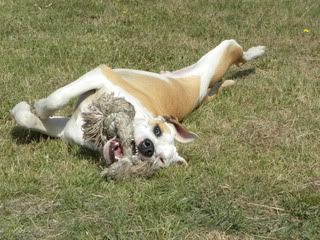

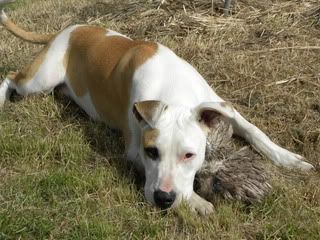
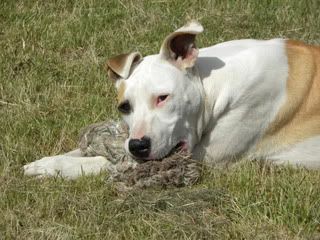 7
7
Comments
-
Lovely story Sweeper, and your dog is just fab!!!:D0
-
Ahhhh he's only gorgeous!!!
Couple of things I'd add -
1 - Don't use the size of paws as a strict rule as to what size the pup will grow, some breeds have bigger paws than others so mixes can be very hard to judge sometimes. Spaniels can have dinner plates on the end of their legs but some greyhounds have really dainty feet!
2 - Rescues can often have a hard time guessing breeds for pups that come in without a mother, ugly 'terrier' pups often turn out to be greyhounds or lurchers! My neighbour fell in love with a foster pup I had, I told her our best guess was staffy or staffy x, well didn't the fecking dog hit 30 kg and keep going! More like mastiff x and a hoosh of boxer for good measure Luckily though she wouldn't have him any other way
Luckily though she wouldn't have him any other way
Here he is with my mini JRT first at 6 weeks when he was found, and then at 18 months and still growing! Bear in mind my mini JRT is 4kg......
So if the size of your dog is very important then don't pick a pup that we call in the rescue I volunteer for a take-your-pick pup, ie "take your pick of what breed you think he is cos there's no way of knowing for sure, we'll give you our best guess but we'll just have to wait and see what he turns into". Personally I don't care what size my dogs are so the oddest looking mongrals suit me just fine 0
0 -
I call them Kinder Surprise Eggs, you never know what you get
 . 0
. 0 -
Did Gus come from a pound or from a rescue group? I think it's important to distinguish between the two. (He's a hunk, by the way!)
Our rescue group would never rehome a pup with fleas - and if there was a suspected skin problem, they'd be off to the vet first thing. All our pups get wormed, vaccinated and any ailments seen to. That's not something that happens with the poor pound puppies.
Too Many Dogs, that second photo is hillarious! 0
0 -
I call them Kinder Surprise Eggs, you never know what you get
 .
.
Love it!
I mean seriously, who would have thought that tiny innocent face would have grown into that huge big lump??? :eek:
I'm not surprised by much anymore with dogs but he shocked the sh!t out of me! And my friend lives in a tiny tiny house, literally 3 small rooms plus bathroom, she shows how perfectly happy a dog can be no matter the size of the house as long as they have company and exercise, he and her other dog get 2 walks a day and there's no bother with them0 -
Advertisement
-
Did Gus come from a pound or from a rescue group? I think it's important to distinguish between the two.
Gus is of complicated origins. He was surrendered to an overzealous rescue who commit beyond their resources, become hysterical when challenged, and have a tendency to 'puppy trading', e.g. travelling to the pound, using their permit to adopt all the immediately rehomeable puppies, getting the vet to whip their knackers off and selling them on.
So yes, he came from a shelter - a no-kill rescue, not a pound, and he cost $395 desexed. He should also have been - and wasn't - flea treated, wormed, fed to the appropriate weight and given vet treatment for his black, tar-filled ears, and his ringworm.
It's an aside to this story, but the rescue responsible (Australia, not Ireland) were closed two weeks before Christmas by their local council for non-compliance with permit laws, and overcrowding. Instead of complying quick sharp, the woman who runs it persuaded her 25,000 facebook page supporters to lobby the council to allow her to reopen.
The entire sorry, ridiculous farce is a perfect example of animal rescue gone ridiculously wrong, tbh.0 -
beautiful dog, deffo looks like there is staffy in him somewhere.0
Advertisement
